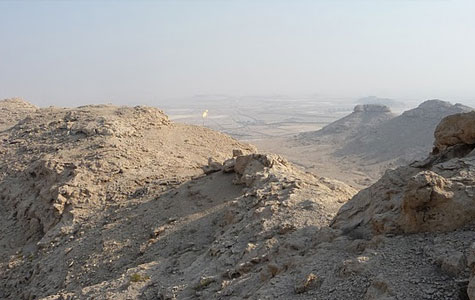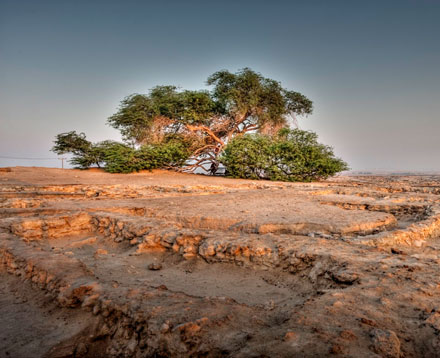Bahrain
Country statistics

Land area: 239 sq miles (619 sq km)
Total area: 257 sq miles (665 sq km)
Population (2010 est.): 738,004 (growth rate: 1.2%); birth rate: 16.8/1000; infant mortality rate: 14.7/1000; life expectancy: 75.4; density per sq km: 1,080
Capital City: Manámah
Monetary unit: Bahrain dinar
Languages: Arabic, English, Farsi, Urdu
Ethnicity/race: Bahraini 62.4%, non-Bahraini 37.6% (2001)
Religions: Islam (Shiite and Sunni) 81%, Christian 9%
Country introduction

Bahrain is a generally flat and arid archipelago in the Persian Gulf, just east of Saudi Arabia and north of Qatar, about 24 to 32 km (15 to 20 miles) away from each. It consists of a low desert plain rising gently to a low central escarpment with the highest point the 134 m (440 ft) Mountain of Smoke (Jabal ad Dukhan). Farming date palms and fruits is made possible, only to the north and north-east of this mountain, by the use of artesian wells, springs and desalination plants.
As an archipelago of 33 islands, Bahrain does not share a land boundary with another country but does have a 161 km (100 miles) coastline. Bahrain's largest islands are Bahrain Island, Muharraq Island, Umm an Nasan, and Sitrah. Bahrain Island makes up 83% of the country and the the four largest islands combined is 95% of the land mass.
Manama (Al Manamah), the capital, is located on the northeastern tip of the island of Bahrain. The main port, Mina Salman, also is located on the island, as are the major petroleum refining facilities and commercial centers. Causeways and bridges connect Bahrain to adjacent islands and the mainland of Saudi Arabia. The oldest causeway, originally constructed in 1929, links Bahrain to Al Muharraq, the second largest island.
About 92% of Bahrain is composed of low desert plain, with some small lagoons. Bahrain has mild winters and very hot, humid summers. In the summer, the average temperature is about 86 degrees to 104 degrees Fahrenheit. In cooler months, the average high temperature doesn't drop much below 70. Periodic droughts and dust storms are the main natural hazards for Bahrainis. The marine habitats are very diverse, including seaweed beds, marshes and coral reefs as well as coastal islands. The country's natural resources include large quantities of oil and natural gas as well as fish in the offshore waters.
The culture

Frequently referred to as the pearl of the Gulf, Bahrain has a history of civilizations that date back more than 5,000 years. The ancient site of the immortal land of Dilmun, and a religious centre for ancient Sumerians, Babylonians and Assyrians at different times, Bahrain's strategic location has ensured that it maintain a heritage of multiculturalism and diversity.
With centuries upon centuries of human habitation packed into one compact site, many legends have enveloped the land of Bahrain. One such example is the historic reference to Bahrain as the Island of Eternity, a result of the multitude of ancient burial grounds found throughout the island, before modern archaeological findings explained them to be a legacy of the Dilmun era.
Today the surrounding islands are made up of a wide variety of different people and cultures. Because of this, Bahrain is somewhat of a cultural melting pot. With over half the population being mostly native-born Bahrainis, the Arab customs and Bahrain culture reign supreme. However, western customs have penetrated the country and as a result, it is one of the more progressive Arab countries in the Middle East.
Bahrain is a Muslim country and most of the culture revolves around that. However, the overall Muslim population continues to decline as more and more non-Muslim immigrants come to the country looking for work. Most of the practicing Muslims follow shia, which is the second largest denomination of Islam. In addition, Bahrain has the largest Christian following in the Persian Gulf. It is also the only country in the Arabic Middle East to have an active Jewish community.
There are a number of Islamic festivals that happen in Bahrain all year round. People get together on these festivals and enjoy to their heart's content. The most important and the holy month in the Islamic calendar is Ramadan. This is the time when the Muslims fast for the entire month. There is usually no activity during the daytime and all the shops are shut down as they fast from dawn to dusk. No one is allowed to eat, drink or smoke in public during the month of Ramadan. Feast of Sacrifice or Eid ul Adha is a three day religious festival held in Bahrain every November. Meat is distributed amongst the poor, family and friends by the rich and everyone else who can afford it. Bahrain also celebrates its National Day in December every year with parades, speeches, marches, firecrackers and special events.
Bahraini cuisine includes food staples such as meat, fish, rice, and dates. One of the traditional dishes is machboos, which consists of meat or fish served with rice. Another known food is muhammar, which is sweet rice served with dates or sugar. Bahrainis also eat other Arabian food such as falafel, fried balls of chickpeas served in a bread, and shawarma, lamb or chicken carved from a rotating spit and wrapped in pita bread. Traditional snacks include samosa and pastry.
Attractions & landmarks

One of Bahrain's most famous attractions is the Tree of Life, a mesquite tree at the highest point of the country. The lone tree is located in the middle of the desert, miles away from any other plant life. To this day, the tree's source of water remains a mystery. Some believe it gets its nourishment from an underground spring but that doesn't explain the complete lack of vegetation in the vicinity. Local lore dates the tree in millenniums but botanists say it may be several hundred years old. Since October 2010, archaeologists have unearthed pottery and other artefacts in the vicinity of the tree, some of which may date back to the Dilmun civilisation.
A small place that's both beautiful and relaxing is the Al Dar Islands of Bahrain. These comfortable islands provide quaint hospitality, accommodations and activities for families and the perfect setting for a refreshing, intimate wedding. While the Middle East isn't known for its beach lifestyle, the Al Dar Islands surprise the tourist with its tropical settings and great scenery. Don's miss out on visiting Sitra's Fishermen's Port.
Another great attraction is the Bahrain Fort, or Qal'at al-Bahrain. Both the museum and the old ruins are definitely worth the visit. Its location on the coast is picturesque and the history is rich. Historically, the fort was originally built for reasons of trade and protection. For Bahrain, it's one of the few true remaining historical sites and everybody should make a point of visiting the incredible edifice.
For a laid back and simple holiday, the Bahrain City Centre provides all of the normal attractions of a normal city. Visitor will find water parks and mall shops, as well as eateries and great places to pick up souvenirs. The inside of the mall is dark and sleek, the parking facilities are great and there is a play area for children to stay while parents shop around the mall.
For those more interested in the religious heritage of Bahrain, the Al Fateh Mosque, or Great Mosque, provides a great example. It is one of the largest mosques in the world, encompassing 6,500 sq m (21,325 sq ft) and having the capacity to accommodate over 7,000 worshippers at a time. The mosque is the largest place of worship in Bahrain.
Opened in 1988, the main museum of Bahrain, the Bahrain National Museum, is a great place to visit to learn the rich history and culture of the island. Different periods of Bahrain's history are examined from Dilmun (circa 3000 BC) and Tylos (circa 300 AD) to the Islamic period (from 7th century AD) to the present day. With reconstructions, ceramics, sculptures, Arabic calligraphy and Quárans, the museum tells the story of Bahrain's history, culture and traditions in an interesting and exciting way.
The Ad-Diraz Temple is a series of ruins that are considered to be part of the Dilmun culture. The architecture that is left is very lovely and helps to illustrate the former age of the Bahrainians that came before. The most recent of the three Barbar temples was rediscovered by a Danish archaeological team in 1954. A further two temples were discovered on the site with the oldest dating back to 3000 BC.
It is highly recommended to visit The Al Areen Wildlife Park to see over 500 animals and more than 100,000 plant species, most native to the Arabian peninsula. Some animals, such as the Chapman's zebra and gazelles, run free. Selected species are kept in pens that mimic their natural environment. The family-friendly park opened in 1975 and offers a chance to see some of Arabia's rarest creatures, including the Oryx which is considered to be nearly extinct.